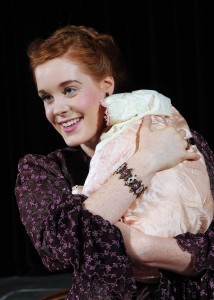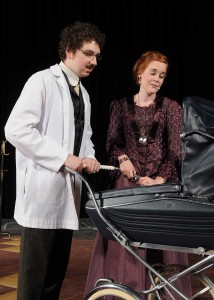 Sarah Ruhl’s In The Next Room, or The Vibrator Play, directed by URI associate professor Bryna Wortman, delivers — in multiples — exactly what the titillating subtitle promises. Yes, this play is about the advent of the vibrator in the late 1880s. An invention that single-handedly brought about – usually in 3 minutes or less — many a cure for female “hysteria” plaguing women in the Victorian era. And yes, while Ruhl’s play tackles issues of sexuality and self-gratification head-on with broad humor, it is at heart a deeper look at intimacy, innocence and a quest to understand ourselves as men and women, husbands and wives.
Sarah Ruhl’s In The Next Room, or The Vibrator Play, directed by URI associate professor Bryna Wortman, delivers — in multiples — exactly what the titillating subtitle promises. Yes, this play is about the advent of the vibrator in the late 1880s. An invention that single-handedly brought about – usually in 3 minutes or less — many a cure for female “hysteria” plaguing women in the Victorian era. And yes, while Ruhl’s play tackles issues of sexuality and self-gratification head-on with broad humor, it is at heart a deeper look at intimacy, innocence and a quest to understand ourselves as men and women, husbands and wives.
The story takes place in and around the home of the staunchly clinical Dr. Givings (a sprightly Belamy Brophy-Baermann) and his lovely, albeit flighty, wife Catherine (Christine Dickinson). The good doctor has a home office in the adjoining room where he treats his (mostly female) clients for the effects of “hysteria” with the very latest in medical technology – said vibrator, of course.
The towering Mr. Daldry (played by Christopher Morris) soon arrives with his delicate wisp of a wife, Mrs. Sabrina Daldry, (luminously played on October 22 by understudy Emily Carter.) Status quo loving Mr. Daldry is unhappy with his wife’s lack of energy, lamenting she has stopped putting her hands on their piano – or anything else for that matter.
 Sabrina, while reticent at first, responds quite readily — and audibly — to the treatments. Circling the empty parlor with an ever-increasing curiosity about the goings on in the next room is Catherine. Dickinson brings a nice sense of neurotic anxiety to the role; she seems unable to quell the stream of doubts running through her head and when she meets anyone, the thoughts seem to come tumbling out of her mouth before she has a chance to stop them.
Sabrina, while reticent at first, responds quite readily — and audibly — to the treatments. Circling the empty parlor with an ever-increasing curiosity about the goings on in the next room is Catherine. Dickinson brings a nice sense of neurotic anxiety to the role; she seems unable to quell the stream of doubts running through her head and when she meets anyone, the thoughts seem to come tumbling out of her mouth before she has a chance to stop them.
New patient Sabrina is soon coming on a daily basis (yes, pun intended) and we see her peeling away layer after layer of her socially dictated identity in preparation for her “treatment” – out comes the hatpin, off comes the skirts, jackets, the bustles, the corsets and various underthings. The time that these dressings and undressing take on stage (and mind you there are MANY) is a constant reminder of how tightly bound and suppressed a woman was under the rules of Victorian etiquette. As Sabrina begins to discover her sexual desires, she soon loses all interest in the machinations of the clinical treatment and yearns for the touch of the Doctor’s longtime assistant, Annie (a wonderfully grounded and sweet performance from Celine Montauay).
Meanwhile, Catherine has descended into more self doubt about her status as wife and mother with the introduction of wet nurse Elizabeth into their home. Daraja Hinds plays Elizabeth with a sense of wisdom and quiet strength. Her emotional monologue about the tragic loss of her own infant son in the second act is wonderfully handled and very compelling.
The second act opens with the unexpected introduction of lovelorn artist and bon-vivant Leo Irving, played by the energetic Diego Guevara. Immediately diagnosed as having the rarely seen “male hysteria” Irving soon is undergoing a series of homoerotic treatments via the Doctor’s “magic wand” that are played for broad laughs by director and cast. Soon Irving is deemed cured, yet becomes the object of unwanted affection by the lonely and vulnerable Catherine, much to her husband’s growing dismay.
As Dr. Givings, Brophy-Baermann imbues his character with an unbridled enthusiasm for the science of things, excited only by the possibilities of healing his patients via this handy new instrument. Handling the role with deft comic timing, his Doctor is closer to a nebbish Michael Cera-type rather than an older, wiser character – something that actually worked very well for the part’s necessary obliviousness to the intense sexual awakenings happening to those around him.
As designed by guest artist Cheryl deWardener, and lit by designer Jen Rock, the set smartly showcases the divide between the two sexes via the two adjoining rooms – Catherine’s impeccable velvet and damask covered womb of a parlor bathed in soft electric light is a stark comparison to the wooden cornices, leather examination table and hard edges of the doctor’s clinic.
Thanks to the gorgeously rendered period designs from costume designer Marilyn Salvatore, the women are charming examples of Victorian perfection — effortlessly coiffed and bedecked with ruffles and bustles and bows. Whatever inner issues are troubling them, these women look as flawless as china dolls on the outside.
While this production is as solid as one could ask for at the non-professional level, I did find myself becoming impatient with the second act’s structure of “unexpected” comings and goings. While I respect Ruhl’s uncanny ability to interweave seemingly random thoughts to reveal a well-constructed narrative, this “oh, who is it now?” doorbell convention became somewhat repetitive to the detriment of the play.
URI’s production of In The Next Room, or The Vibrator Play continues October 23 and October 24 at 7:30pm with a Sunday matinee on October 25 at 3pm in the Robert E. Will Theatre in the URI Fine Arts Center, 105 Upper College Road on the Kingston Campus. Tickets available online at web.uri.edu/theatre, or by calling 401-874-5843.
More Posts by The Author:
Rewriting the Rules: Collaboration Is the Engine Driving WomensWork’s Madwoman in the Volvo
Theater as Activism: “The Clinic” features all-star cast to benefit women’s reproductive rights
Stage Presence: Korey Pimental and Taylor Corbett chat about The Glass Horse Project, staging LaBute in New Bedford and the need to see differently-abled talent on stage
Singer Katie Kleyla Trades the Jazz Mic for the Spotlight Onstage in All Shook Up at the Community Players
Mild-Mannered Professionals by Day — Bawdy Singing Romans by Night! Meet the Cast of Barker’s A Funny Thing Happened on the Way to the Forum


